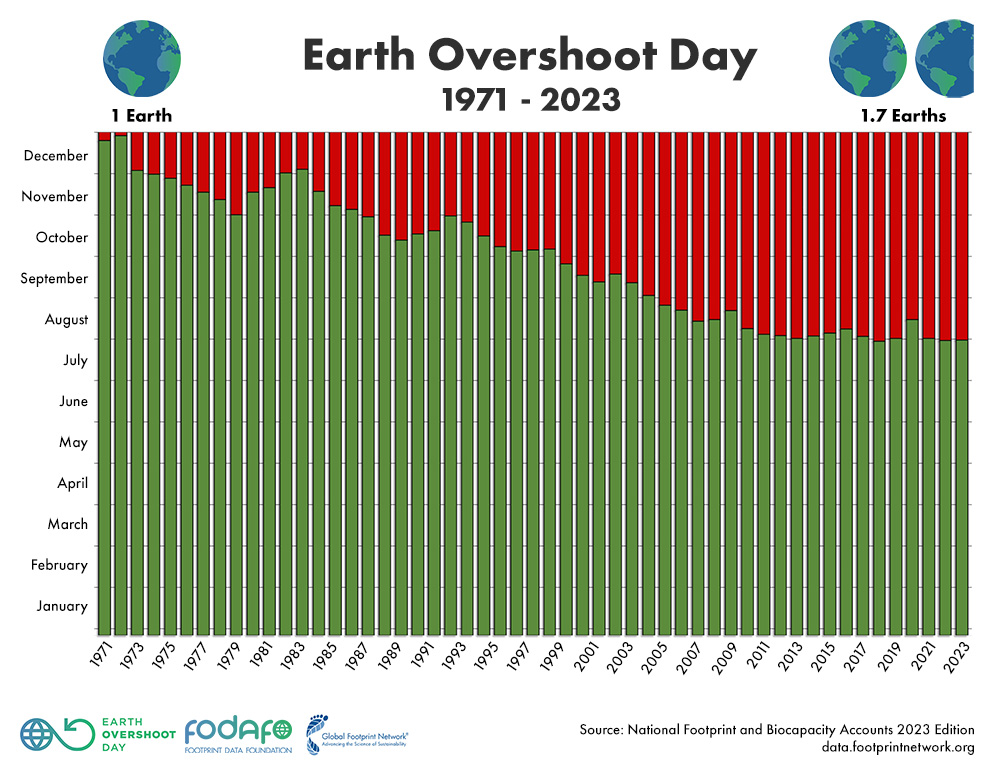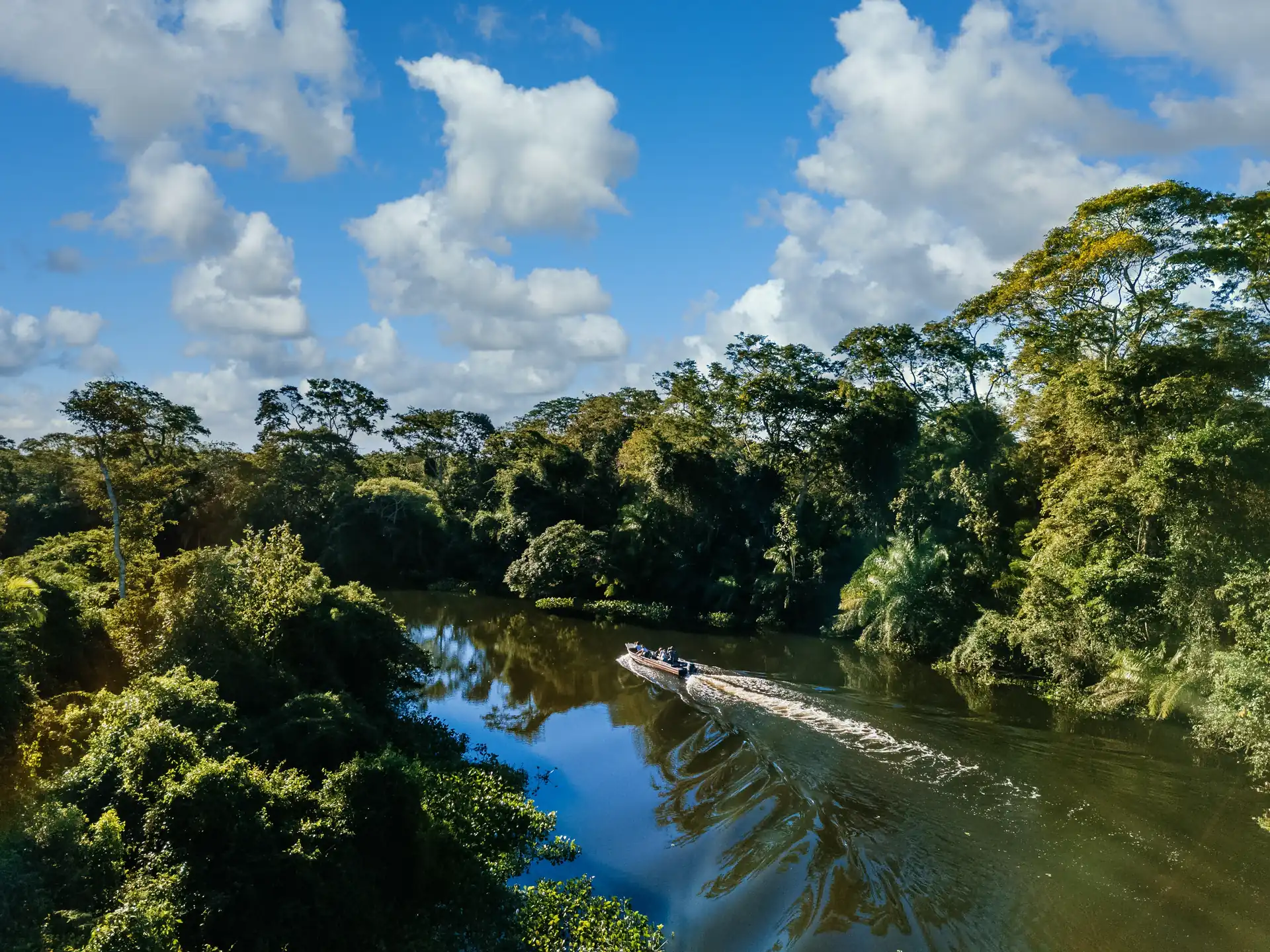Ecological Footprint and Biocapacity: Strategies to Address the Environmental Crisis and Promote Regenerative Development
Although it may seem like an isolated crisis, the current civilizational crisis, known as the Anthropocene crisis—or the era of significant human impact on the planet—is composed of a variety of causative failures related to human activity. These include climate change, ocean pollution and acidification, changes in precipitation patterns, desertification of land, massive loss of biodiversity, and, most importantly, income disparity. The ecological footprint is a somewhat obscure concept underlying all of these phenomena. The term, proposed by Mathis Wackernagel and William Rees in the 1990s, has gained importance as a measure of the impact of the current model.
In Wackernagel’s (2008) words:
“The Ecological Footprint is a resource accounting tool that measures how much of the Earth’s regenerative capacity is demanded by a given activity. […] By comparing the amount of capacity demanded with the amount of capacity available each year, ecological footprint accounting can measure the extent to which human demands on the biosphere exceed its capacity.”
Biocapacity, on the other hand, is the ecological income, the natural capital that sustains economic development—in other words, all the natural goods that support spending in the current economic paradigm. The imbalance between the ecological footprint and biocapacity converges in a critical situation known as Earth Overshoot Day. This date marks the point in the year when the demand for natural goods exceeds the planet’s capacity to regenerate them.
The ecological footprint indicates that many countries are using natural resources unsustainably. Since the 1970s, global demand for resources has consistently exceeded the planet’s biocapacity, leading to ecosystem degradation, biodiversity loss, and, most importantly, the onset of climate change. In developed nations, where per capita consumption levels are significantly higher, this imbalance is even more evident.
What is Earth Overshoot Day?
The Global Footprint Network introduced the concept of “Earth Overshoot Day” to pinpoint the date when humanity has consumed all the resources that the Earth can regenerate in a year. This date arrives earlier each year, reflecting the steady increase in the global ecological footprint. August 2, 2023, was Earth Overshoot Day, indicating that humanity exhausted the Earth’s annual ecological budget in less than seven months.
This phenomenon has significant implications for life expectancy. Overconsumption of resources leads to ecosystem degradation, affecting the planet’s ability to provide essential services such as clean water, pure air, and food. Moreover, it contributes to climate change and biodiversity loss, exacerbating the global environmental crisis.
.
Countries According to Their Overshoot
The distribution of overshoot varies significantly among countries. The per capita ecological footprint of nations with more advanced economic development is significantly higher, reflecting their high levels of consumption and production (Global Footprint Network, 2023). The biological capacity of the United States and the European Union member countries is much greater. On the other hand, many developing nations have a smaller ecological footprint but face additional challenges due to the degradation of their local ecosystems.
Why is Biocapacity Important for the Health of Our Planet?
The concept of biocapacity is fundamental to environmental sustainability. It represents the ability of an area’s ecosystems to produce renewable biological resources and absorb waste, such as carbon dioxide. A country’s or region’s biocapacity is affected by various factors, including natural resource management practices, soil quality, and climate (Kitzes et al., 2008).
A robust biocapacity is essential for the global health of the planet. Functional ecosystems provide a variety of important ecosystem services, such as water purification, climate regulation, and crop pollination. Conversely, a loss of biocapacity can lead to desertification, water scarcity, and decreased agricultural production, negatively impacting both human communities and biodiversity.
Why is the Amazon Bioregion So Important?
Due to its great biodiversity and significant role in global climate regulation, the Amazon bioregion stands out as one of the most important areas for global biocapacity. This ecosystem contains approximately ten percent of all known animal and plant species in the world. The Amazon forests are essential carbon sinks and are crucial for mitigating the effects of climate change worldwide.
However, deforestation and other human activities, such as agriculture and mining, endanger this region. The loss of biocapacity in the Amazon not only affects local populations and biodiversity but also has global implications, reducing the planet’s ability to absorb carbon and regulate the climate.
Regenerative Development for Biocapacity Growth
Beyond traditional sustainability, regenerative development is an advanced strategy. The goal is to restore and strengthen the capacity of ecosystems to regenerate themselves. This approach employs resource management techniques that not only reduce negative impacts but also enhance biocapacity (Mang & Reed, 2012).
Regenerative development is based on principles of ecological design and integrated systems that work in harmony with nature. For example, regenerative agriculture improves soil health and increases agricultural productivity using methods such as composting, crop rotation, and agroforestry without damaging natural resources. Similarly, sustainable forest management and the restoration of degraded ecosystems can significantly increase biocapacity, benefiting both the global environment and local communities.
Strategic Actions for Ecosystem Regeneration
Strategic actions for ecosystem regeneration are essential to increase biocapacity and mitigate the environmental crisis. These include:
1. Restoration of Degraded Ecosystems:
Ecological restoration is the process of rehabilitating degraded areas through reforestation, vegetation expansion, and the reintroduction of native species. These actions can enhance biocapacity by increasing the biological productivity and biodiversity of ecosystems.
2. Regenerative Agriculture:
Regenerative agriculture uses methods that improve soil health, increase biodiversity, and adapt to the climate. This includes holistic grazing management, crop rotation, and the use of cover crops (LaCanne & Lundgren, 2018).
3. Conservation and Sustainable Forest Management:
Biocapacity depends on the conservation and sustainable management of forests. This can include implementing reforestation programs, promoting sustainable logging practices, and preserving existing forest areas (Chazdon et al., 2020).
4. Environmental Policies and Regulations:
It is imperative that governments and international organizations establish and enforce policies and regulations that promote resource conservation and regenerative development. This includes incentives for the implementation of sustainable agricultural practices, biodiversity preservation, and carbon emissions reduction (Ostrom, 2009).
5. Education and Awareness:
Education and awareness are essential to promoting a culture of sustainability and regeneration. Educational programs and awareness campaigns can empower communities to adopt practices that increase biocapacity and mitigate environmental impact.
Conclusions
Understanding the relationship between ecological footprint and biocapacity is essential for comprehending environmental sustainability and addressing the global ecological crisis. Each year, Earth Overshoot Day arrives earlier, highlighting the growing mismatch between the demand for natural resources and the planet’s capacity to regenerate them, leading to a state of overshoot. This situation is unsustainable and requires a drastic change in consumption and production patterns worldwide.
The ecological footprint of developed countries is significantly greater than the biological capacity of developing countries, according to an analysis of biocapacity disparities between different nations. Meanwhile, many developing countries face additional challenges due to the degradation of their local ecosystems. Since healthy ecosystems provide essential services such as climate regulation, water purification, and food production, biocapacity is crucial for the planet’s health.
Due to its high biodiversity and contribution to climate regulation, the Amazon bioregion stands out as one of the most important areas for global biocapacity. However, it faces significant threats due to deforestation and other human activities, making conservation and restoration actions necessary.
A promising solution to increase biocapacity and reduce the negative effects of the environmental crisis is regenerative development. By seeking to restore and enhance ecosystems’ regenerative capacity, this approach goes beyond sustainability. Actions that can increase biocapacity and generate long-term benefits include the implementation of regenerative agricultural practices, restoration of degraded ecosystems, and sustainable forest management.
Furthermore, it is crucial that governments and international organizations establish environmental policies and regulations that promote conservation and regenerative development. Education and awareness are also essential for empowering communities to adopt sustainable practices.
In summary, addressing the environmental crisis and fostering a sustainable future requires a comprehensive approach that combines reducing the ecological footprint with increasing biocapacity. Through regenerative development and the implementation of strategic actions, we can achieve a sustainable balance between human consumption and the planet’s regenerative capacity.
Jhon Enrique Bermúdez Tobón
Ph.D. (c) in Tourism (UAB)
Master’s in Sustainable Tourism Management (UCI)
Sustainable Tourism Administrator (UTP)
Bibliographic sources
Chazdon, R. L., Brancalion, P. H. S., Lamb, D., Laestadius, L., Calmon, M., & Kumar, C. (2020). A policy-driven knowledge agenda for global forest and landscape restoration. Conservation Letters, 13(1), e12669. https://doi.org/10.1111/conl.12669
Global Footprint Network. (2023). Earth Overshoot Day 2023: Press release. Retrieved from https://www.footprintnetwork.org/our-work/earth-overshoot-day/#:~:text=In%202023%2C%20Earth%20Overshoot%20Day,carbon%20dioxide%20in%20the%20atmosphere.
Hobbs, R. J., & Harris, J. A. (2001). Restoration ecology: Repairing the Earth’s ecosystems in the new millennium. Restoration Ecology, 9(2), 239-246. https://doi.org/10.1046/j.1526-100X.2001.009002239.x
Kitzes, J., Wackernagel, M., Loh, J., Peller, A., Goldfinger, S., Cheng, D., Tea, K., 2008. Shrink and share: humanity’s present and future ecological footprint. Philos. Trans. R. Soc. B 363, 467–475.
LaCanne, C. E., & Lundgren, J. G. (2018). Regenerative agriculture: Merging farming and natural resource conservation profitably. PeerJ, 6, e4428. https://doi.org/10.7717/peerj.4428
Malhi, Y., Roberts, J. T., Betts, R. A., Killeen, T. J., Li, W., & Nobre, C. A. (2008). Climate Change, Deforestation, and the Fate of the Amazon. Science, 319(5860), 169-172. https://doi.org/10.1126/science.1146961
Mang, P., & Reed, B. (2012). Designing from place: A regenerative framework and methodology. Building Research & Information, 40(1), 23-38. https://doi.org/10.1080/09613218.2012.621341
Network, G. F. (2010). Ecological footprint atlas 2010. Retrieved May, 25, 2014.
Ostrom, E. (2009). A general framework for analyzing sustainability of social-ecological systems. Science, 325(5939), 419-422. https://doi.org/10.1126/science.1172133
Wackernagel, M., & Rees, W. (1996). Our Ecological Footprint: Reducing Human Impact on the Earth. New Society Publishers.




